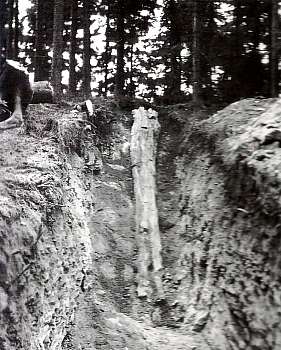Slušně zpracovaná práce, ten dřevošutr se „sklovinou“ je parádní.
Mám rád články s osobním přínosem, tenhle je moc zajímavý.
Petrified Forest in East Bohemia
Categories: Finds and rescue research in the Czech Republic
East Bohemia is not a very rich area paleontologically or even mineralogically. Nevertheless, there are places where you can find some remnants of prehistoric life or a nice stone. One such place is, for example, the Metuje river basin with its fossilised primordial wood-aracharites.
These remnants of the prehistoric forest that was the basis of the coal seams, after extensive changes in water flows in the Tertiary and Quaternary periods, are found floating in a wide area defined by the towns of Jaroměř, Nové Město nad Metují and Rychnov nad Kněžnou. The primary origin of the Araucarites is, however, to be sought in the Jestřebí Mountains and Broumovská vrchovina area about 25 km away. In this area there is a wide band of Permo-Carboniferous carbonaceous sediments of the Žacléř Formation, belonging to theCarboniferous sediments of the Vestfal and Stefan stages, 310-298 million years old, and Permian sediments of the Autun and Saxon stages, 298-272 million years old.
The above-mentioned cities represent the maximum identified area of distribution of fossilized wood. Their greatest occurrence is situated in the vicinity of the Metuje River, for example in the collector-famous Šestajovice. Unfortunately, the best pieces have become rather scarce during the time this locality has been known. Today, it is possible to find fossil wood in its original place of occurrence, for example at the Kryštof Stones or in the vicinity of Žaltman and Radvanice, where it was still in the early 20th century. (Attention, both sites are protected!)
I collected in the fields around Jasenna, located about 2 kilometres south of Šestajovice, where I managed to obtain a large number of specimens of varying quality and size without much effort. Smaller fragments occur all over the surface of the fields, to find larger pieces, it is a good idea to focus on areas where ground-up boulders of various rocks and gravel are visible on the field surface.
In about 4 hours of searching I collected about 10kg of rock. Unfortunately, most of the finds do not reach any great aesthetic quality: the colour is in shades of black to grey, with rarely brown or yellow coloured pieces. The size does not exceed 30 cm. Unfortunately, I do not have suitable cutting tools, so I have been limited to processing only smaller samples of dark colour. One of the better results is below; although the vascular bundles are visible in the section, they do not dazzle in colour or texture.
Sources.

map of the occurrence of araucarites in Podorlicko

fossilized trunk from Radvanice, 1930

detail of vascular bundles

the most beautiful piece

one of the better pieces

could look nice after cutting

specimen after cutting

a piece of average colour and size
Unfortunately, most of the finds look like this
The article is included in categories:
Post
Ten dojem "sklovitosti" je jen voda. pro lepší kontrast při focení jsem je namočil. Takhle hezky zbarvených kousků jsem ale bohužel moc nenašel.
Aha, chápu.
Moc povedené kamení i článek
Pěkný článek i kameni tedy araukarity 
Palec za článek 👍
U Šestajovic se pořád ještě dají najít docela dobré kousky... 👌😉
Taky mám jeden ve skalce, část kmenu kde jdou vidět celé letokruhy...
Dobré počtení, taky mám podobné kousky 















